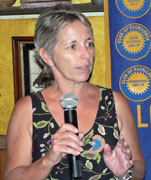Community Emergency Response Team (CERT), by Cheryl Dawson

Cheryl Dawson was born in England, lived on Cyprus, and went to high school in Hong Kong and to college in the UK. She returned to Hong Kong for business management work, including trademark protection and anti-counterfeiting, involving some world travel. She moved to the US and started a company in anticounterfeiting. She has also worked on disaster preparedness as a volunteer in the Palos Verdes School District and is currently District Disaster Chair. She is the Executive Chair of the Palos Verdes Peninsula Community Emergency Response Team (CERT), and is a qualified CERT trainer with certificates in several specialized disaster response fields.
She presented a video map illustration of a 7.8 magnitude earthquake spreading northward from the Salton Sea along the San Andreas Fault, showing its area spread as a function of time from onset (it would take over a minute to reach the Los Angeles area). Such an earthquake would cause an estimated $213 billion damage including 300,000 buildings and widespread infrastructure damage, with 270,000 people displaced, 50,000 injured and 1800 deaths, half of those from fires. (The 1994 Northridge earthquake was 50 times smaller than this.) There would be many fire disasters, decreased water pressure, and saturated communications, and all emergency-response agencies and hospitals would be vastly overwhelmed as well as sustaining damage themselves.
The best preparation is for everyone to be prepared for self-sufficient local response (90% of rescues would be by volunteers). Among home preparations should be strapping the water heater and building foundation, securing furniture and chemicals from movement, assembling an emergency supply kit, checking utilities for leaks and damage, arrange a meeting place in advance with family members and an out-of-state contact (long-distance calls may be more open than local calls). Avoid tying up phone lines if you don’t need to. Don’t rush to school (crowds of others will be trying to do the same thing at the same time).
Supplies available should be enough for total maintenance of all household members for at least 3 days (food, water, medications). There is likely to be little or no support by public agencies for at least 5-7 days. Have first aid supplies, rescue equipment, fire extinguishers (including one in the bedroom), crowbar, and copies of all important documents. Keep supplies in a variety of places, such as car, office, and in multiple places in the home. Keep them refreshed periodically. Have an evacuation kit. Emergency water supplies would include draining the hot water tank or toilet tank, having water in drums, fill gallon bottles with water ahead of time, and use water from a pool or spa.
You can also take CERT training, 20 hours by the Los Angeles County Fire Dept or School District. The County Fire Dept has a FEMA-developed CERT program in a series of 3 classes on 3 consecutive Saturdays starting October 27, 8:30 AM to 4 PM, at Marymount College (Lower Cecilia Hall). To enroll, e-mail rhenw90274@gmail.com or call (310) 375-8747, giving your name, phone number and e-mail address. Class size is limited.
To help your neighborhood, you need to know your neighbors, especially those with special needs and disabilities. Learn how to size up and put out a fire, safely search rooms and remove victims, triage victims to prioritize the order of helping them, learn how to organize teams, understand disaster psychology and anti-terrorism efforts, and understand how to hand over to first responders when they arrive. You should also join Neighborhood Watch. You can learn CPR, and take ham radio classes to enable emergency communications when other means are unavailable. Learn and write down important local phone numbers such as the Lomita Sheriffs Station and the emergency response office for your city. For additional preparation information, you can contact www.pvpcert.org, or www.ready.gov for general FEMA preparedness information, or the Red Cross.